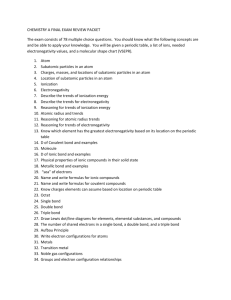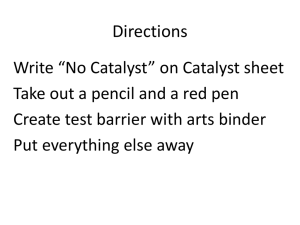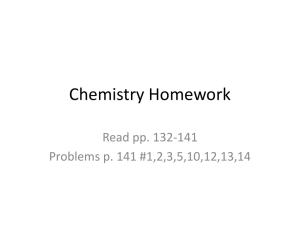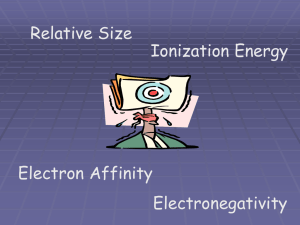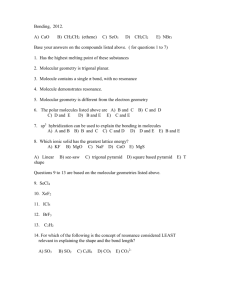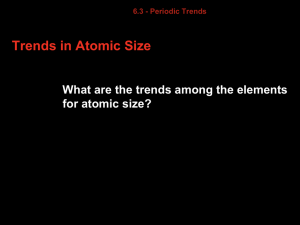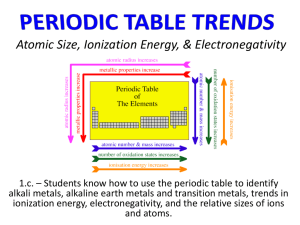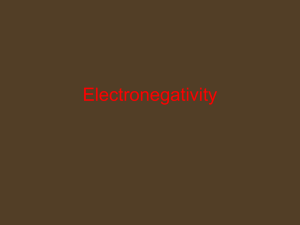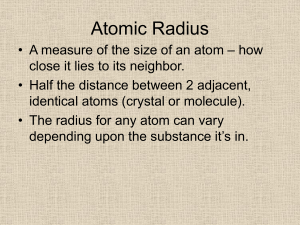Bonding
advertisement
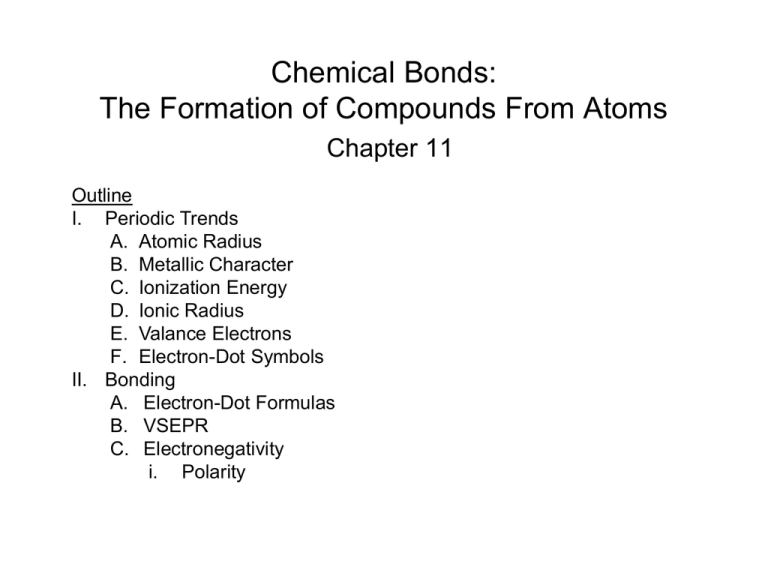
Chemical Bonds: The Formation of Compounds From Atoms Chapter 11 Outline I. Periodic Trends A. Atomic Radius B. Metallic Character C. Ionization Energy D. Ionic Radius E. Valance Electrons F. Electron-Dot Symbols II. Bonding A. Electron-Dot Formulas B. VSEPR C. Electronegativity i. Polarity Periodic Properties • Atomic Size – determined by how far the outermost electrons are from the nucleus Example – Atomic Size Which has the larger atomic size? Li or K and Li or F A. K, Li B. Li, F C. K, F D. Li, Li E. Not enough information Periodic Properties • Metallic Character Example – Metallic Character • Which has more metallic character: S or Na? Periodic Properties – Ionization Energy Ionization Energy Example – Ionization Energy Which has the higher ionization energy: Mg or Ca? Example – Ionization Energy Which has the higher ionization energy: Sn or Pb? Example – Ionization Energy Which has the higher ionization energy: Se or S? How does the radius of a cation differ from an atom? What happens when an atom loses an electron? How does the radius of an anion differ from an atom? What happens when an atom gains an electron? How do atoms bond? What does a formula unit look like? What is one way that a metal obtains an octet? What is one way that a nonmetal obtains an octet? Example – Ionic Bonding • What is the Lewis structure when aluminum and chlorine form an ionic compound? A. B. C. D. What compound will be formed by the reaction of potassium and chlorine? What compound will be formed by the reaction of magnesium and oxygen? What compound will be formed by the reaction of sodium and sulfur? What compound will be formed by the reaction of calcium and chlorine? How can we estimate the bond length of a molecule? What does the bonding in H2 look like? + 1s1 1s1 How does Cl2 bond? + [Ne]3s23p5 [Ne]3s23p5 What orbital(s) does Cl2 use to bond? Cl:[Ne]3s23p5 How does O2 bond? + How many valence electrons are shared? How many valence electrons are shared in N2? What are the diatomic elements? How does H2O bond? Are all the valence electrons shared? + + or Does each atom have a complete outer shell? Example – Covalent Bonding • What is the Lewis structure for formaldehyde, CH2O? A. B. C. D. What is the shape when 2 atoms are attached to the central atom? What is the shape when 3 atoms are attached to the central atom? What is the shape when 4 atoms are attached to the central atom? What is the shape when 3 atoms + lone pair are attached to the central atom? What is the shape when 2 atoms + 2 lone pairs are attached to the central atom? Example – VSEPR Theory • What is the molecular geometry for hydrogen sulfide? A. tetrahedral B. trigonal planar C. trigonal pyramidal D. bent E. linear Example – VSEPR Theory • What is the bond angle for the thiocyanate ion, SCN-? A. 109.5° B. 107° C. 180° D. 104.5° E. 120° What is electronegativity? How does electronegativity change on the periodic table? Example – Electronegativity • Rank the following in order of increasing electronegativity: F, Ga, K, Rb, and V. A. F < Ga < K < Rb < V B. Rb < K < V < Ga < F C. V < Rb < Ga < K < F D. F < Ga < Rb < V < K E. Rb < F < K < V < Ga How do bonds differ? How are electrons shared in Cl2? How are electrons shared in HF? Is H2O a polar or nonpolar molecule? Is CO2 a polar or nonpolar molecule? What is the direction of the net dipole? Can a nonpolar molecule have polar bonds?


